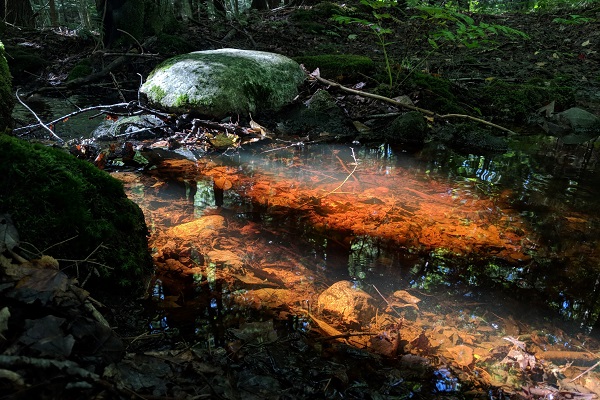
This captivating section of the Firth Lake Segment in Chippewa County evoked fond memories of the time spend building it. Photo by Ryan Jansen.
Article by thru-hiker, Ryan Jansen
Three weeks or 30 minutes. Both are amounts of time, separated by a year, I spent on the Firth Lake Segment. The two experiences were very different. One occurred while I was a crew member with Wisconsin Conservation Corps (WisCorps) and the other while on my 2018 thru-hike.
Both had the similarity of being experienced through the lens of a unique perception of time. Trail-Time. A meditative, obligation-free state of mind. The senses peak to the point of almost combining. My thoughts felt 3D and immersive, to the point where I struggle to say if I was fully in my head (my brain often was occupied with thoughts to the point of blocking out my surroundings) or out of my mind (my thoughts felt like they left my skull and were in plain sight).
I have learned to appreciate (and crave) this variation in perception, especially when compared to time in day-to-day life. Employment is necessary and generally comes with a 9-to-5, Monday through Friday schedule. It’s a sense of time constructed out of obligation, schedules, and routine. Add something as common as electricity, and we stay up later and get up earlier. It’s easy to get way outside our natural body clocks and rely on alarms to start our days.
I discovered Trail-Time during the fall of 2017 while I was employed with the WisCorps as part of a 2.5-month crew. We had week-long stints in state parks and county parks across southern Wisconsin, but one project stood out. Three weeks in the north woods with the Ice Age Trail Alliance. The Mobile Skills Crew (MSC) volunteers showed up after we had been working on part of the Firth Lake re-route for a week. Some of ya’ll might remember meeting our crew of sober, green-hoodie-toting, food-garbage-disposals that helped out at this event. After the MSC event was over, we stuck around and finished the re-route.
Each work day was spent in a new forest-zone on a hand-built path that we were the first to experience. Re-reading my journal from this time period I had written, “This doesn’t feel like a job; it feels like an ideal way of life.” On crew, my internal clock felt . . . honest. I don’t recall waking up exhausted or snoozing my alarm. Also, I noticed that during and after crew, my depression became significantly less severe. At its worst I would have unwanted intrusive thoughts (about death, suicide, insecurities, social anxiety, etc.) about every hour, and during more manageable periods, these thoughts would budge to the front of my mind a few times a day.
This daily experience was a significant and difficult part of my reality for five years. Yet, at some point, while working on Crew, I felt relief. I was experiencing full days free from intrusive thoughts, which I think can be credited to my lifestyle on crew: daily exercise, spending weeks outdoors, getting enough sleep, eating healthy (our crew ate vegetarian), and experiencing life through the lens of Trail-Time.
When I found myself with the opportunity to participate in more MSC events in 2018, I was thrilled. My only complaint was that five nights in a tent wasn’t enough to get a taste of Trail-Time. There are many reasons I wanted to thru-hike the Ice Age Trail, but my craving for Trail-Time was a significant consideration, especially after realizing its positive effects on my mental health. I figured two more months spent outdoors would hit the nail on the head. So, with the help and aid of advice from community members, friends and family, I planned for and left on my West to East thru-hike.

Sunbeams light up Wood Lake in magical, surreal-feeling moments of Trail-Time along the Wood Lake Segment in Taylor County. Photo by Ryan Jansen.
Trail-Time, I’ve learned, creeps in slowly (like trail hunger). It wasn’t until I was hiking into Chippewa County, I began to notice the subtlety of Trail-Time emerging. Leaving Weyerhaeuser, I was less than thrilled to start my first full day of road-walk. Although, within an hour or so I was forgetting I was on a road because I was engulfed by my imagination. I was surrounded by a cloud of imagery that followed the plot of my thoughts. Occasionally, something in the ditch would catch my eye and I would pop back to reality. Long road-walks became equivalent to a long stop at the creativity bar. I’d have pint after pint of imagination, on-tap, and for free. Trail-Time is a mental state created by simplified routines, the lack of a strict schedule, and extended exposure to the outdoors.
Hiking into the Firth Lake Segment’s 2017 reroute, my Trail-Time experiences were overlapping! Memories from my three weeks building the reroute came flooding back. Each day of work was solidified in 3D space which I now hiked through in the present. With every step forward towards the eastern terminus, I remembered specific conversations, rocks, stumps, clumps of moss, dead trees, times I laughed, locations we cached tools, and found pupae and salamanders. It was a dense experience of memories. My thoughts were free and colorful. I felt sort of out of my mind hiking alone in the woods smiling and laughing, but such was the experience.
The Ice Age Trail has changed my life. It gave me place and space to experience life without depressive thoughts. It taught me how much time outdoors I really need. I highly recommend you take a walk in the woods. Make it last a few weeks or months, because living in the city is conducive to cyclical thoughts. Take the exit off the cultural roundabout. I hope the Ice Age Trail can change your life for the better, too. Allow every day to be the best day of your life.
NOTE: This article previously appeared in the Spring 2019 edition of Mammoth Tales.
Guest writer and Thousand-Miler
Ryan Jansen grew up in the Middleton-Cross Plains area. Over the last 10 years the Ice Age National Scenic Trail has become more and more a part of his life. In October, 2018 he completed a West to East thru-hike which, by his own account is, “by far the coolest thing I’ve ever done.” Ryan emphasizes gratitude, “I am thankful for all the kind-hearted individuals who helped and hosted me along my adventure, to staff and volunteers who make the trail a reality, and to all the selfless donations people make to the Ice Age Trail Alliance.”
